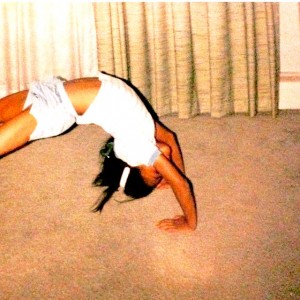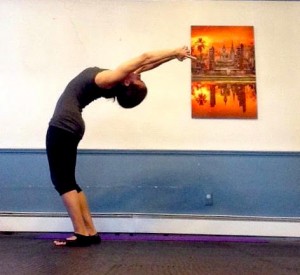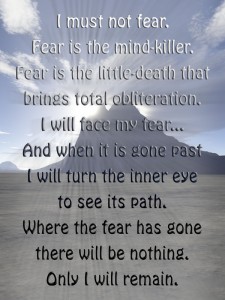 My life revolved around gymnastics for much of my childhood, as I proudly grew from a tiny tumblebee of age 4 to a competitive gymnast in adolescence. As the type of athlete who thrived on strength and speed, one of my absolute favorite things was to go whipping through the air backwards. At the request of my friends, I would not-so humbly tumble through a succession of back handsprings and somersaults at recess for fellow classmates who clapped and cheered me on, “Do it again, do it again!” Back then, I had the fearless daring that bless only those who do not worry about all the ways one can fail, fall or hurt one’s self.
My life revolved around gymnastics for much of my childhood, as I proudly grew from a tiny tumblebee of age 4 to a competitive gymnast in adolescence. As the type of athlete who thrived on strength and speed, one of my absolute favorite things was to go whipping through the air backwards. At the request of my friends, I would not-so humbly tumble through a succession of back handsprings and somersaults at recess for fellow classmates who clapped and cheered me on, “Do it again, do it again!” Back then, I had the fearless daring that bless only those who do not worry about all the ways one can fail, fall or hurt one’s self.
After I was forced to quit gymnastics due to chronic knee problems, I grew 6 inches in height and gained comparable weight within a year and a half. My new body still often felt (and looked) foreign to me, but I put my focus on other athletic endeavors—first, soccer and track & field, then, hiking, rock-climbing, sea kayaking. I still would enjoy tumbling now and then even through college when I’d do back somersaults for my boyfriend during our study breaks. However, the opportunities to do much more than that grew fewer and farther between.
Still, I held onto my daring spirit, continuing to soar–but in airplanes instead. The summer before my senior year, I went to Europe for the first time for three weeks with a group of near-strangers. I returned a year later for a dual graduation celebration with my family. I went to college three thousand miles away, starting life over far from all my friends and my family, except for my brother. During college, I decided to go on a study trek to Nepal with my boyfriend at nearly the last minute, though I’d never seriously camped overnight or hiked long distances for multiple days in succession before.
In those days, even if fear was present, it wasn’t allowed to rule my life.
When Fear Takes Root
In my last trimester of college, a few short months before I’d bid adieu to the last classes of my undergrad years, I was involved in an accident. I was crossing an intersection on campus with my bike when I was hit and knocked down by a classmate rolling through the intersecting stop sign in her car. I was unaware that the seemingly minor tumble to the ground would trigger days, weeks, months, then years of severe pain and both neurological and immunological dysfunction.
As I lost mobility and flexibility due to muscle tension, tight tendons and joint stiffness, I experienced a similar loss in life flexibility. I had to gauge my energy expenditure by duration and severity of activity. I only had a set number of “good hours” in which to get things accomplished. I tried to hold onto as much of my old, productive life as I was able, but I was forced to be stingy with both my time and energy. If I pushed my body too far, I would experience crushing, rebound pain and fatigue for days.
The idea of flying freely through life—both figuratively and literally—felt like a cruel joke I once played on myself. Now, simply touching my toes was often a challenge. It was hard to believe I was ever that strong and mobile—it seemed like another life, another person entirely.
Having to curb my daily activity and social interactions, I also gained fear of situations that might lead to further immobility, through illness or injury. What if I moved the wrong way and tore another tendon or muscle? I’d lived with a torn rotator cuff for two years after the bike accident before I finally got surgery, and I didn’t want to live through that severity of acute chronic pain on top of my daily discomfort again. Having to so severely limit my writing and music making was also incredibly crippling to my soul.
Finding Courage To Fight Back Fear
 Yet just as I needed to rally the courage to perform my own music in front of a crowd again, I needed to regain the confidence to test my body once I finally found myself back on the road to healing. My mom and I took walks regularly and started doing yoga together. I built up to traveling cross-country and going on longer hikes. I started to swim again. I began to feel physical stronger and clearer of mind, and I could feel my confidence growing.
Yet just as I needed to rally the courage to perform my own music in front of a crowd again, I needed to regain the confidence to test my body once I finally found myself back on the road to healing. My mom and I took walks regularly and started doing yoga together. I built up to traveling cross-country and going on longer hikes. I started to swim again. I began to feel physical stronger and clearer of mind, and I could feel my confidence growing.
Life threw another stumbling block at me when my neurological system seemed to completely short out on me in my early 30s. I developed the movement disorder dystonia, which had me unable to control my limbs for lengths at a time—a simple walk to the bathroom could lead to a hard fall to the floor. My renewed fear of movement was justifiable as my mobility was increasingly impaired. Despite the major setbacks, my spirit fought hard to stay alive. I was determined that no matter how many times I literally fell on my face, I would keep getting back up again.
That resilience served me well as I embarked on this path and that path, searching for the answers to put me back on my feet again. I have shared how powerful a role the practice of yoga played in my healing journey. At first, it gave me a sense of control and power at least while I was on the mat. Then, I finally began to feel the healing off the yoga mat as well. As I transformed my diet and made other lifestyle changes, my body retuned its innate vibes and wisdom for good health.
With regained mobility and strength, my life expanded once again. The complexity of my yoga practice increased. One afternoon, I found myself on the springy mat at a martial arts gym, and I braved a tumbling pass across the diagonal. While my arms slightly collapse under me as I flipped back onto my hands, I knew that my arms and legs possessed the strength that would only grow with practice. After a repeat pass, I had successfully flipped through the air without the need for my hands.
Stable, static backbends weren’t as easy to do without the momentum of my sprinting body whipping around at full-speed. So I started rebuilding my foundation. I increased flexibility by practicing bridges and other back-bending poses. I strengthened my shoulders and wrists through handstands and other arm balances. My backbends started looked prettier, and my arms started straightening under me with confidence. I tried backbends with one leg, then backbends resting on my forearms. A few times, I dared to try reaching for a backbend from a sitting down position and successfully, albeit un-smoothly, did so.
Breaking Down The Wall Of Fear
As the months passed by and my backbends grew stronger, my plain fear of falling backward and trusting in my ability to stay on my own two feet and two hands remained. What happened to the little girl who joyfully flipped backwards without a second thought? Approaching 40, I was tentative as I extended into standing backbend pose. Should I try to keep going back down into regular wheel pose? If I fell back onto my hands, I still worried over spraining a wrist or landing on my head and injuring my neck. The wall became my friend—and my crutch.
I knew one day I would have to step away from the wall. So what if I fell on my head? I did it on the regular, trying out crazy, upside down poses and creative, inverted transitions. My thick hair helped cushion the fall, and my scramble reflexes from both gymnastics and soccer always helped me to roll with ease back onto my feet. I realized I wasn’t so much worried about my body’s ability to fall backward without injury as I was fighting the emotion of fear itself.
Last week, I shared how I have been confronting my fears with mantras, or positive affirmations, and the Courageous Heart Mudra. I’ve spent days and weeks doing directed inner work, getting to the root of the fears holding me back from fully embracing my life. I could feel myself gradually achieving small victories in different areas of my life.
So yesterday, when I started to reach back into Anuvittasana, the standing backbend, I wondered, What if I just keep going? I knew I was strong enough to hold myself up; I just needed to trust my hands would blindly find the ground. I took a deep breath, leaned farther back and farther still, as my legs and back bravely braced for impact of all sorts. And then my palms touched the mat. I had finally done it! I found stability holding me aloft, so I continued my upside down play.
I finally had my mind-blowing breakthrough. I broke down that long-lived, crippling wall of fear and found myself standing strong, tall and self-assured on the other side. It’s amazing how my other fears seem small and insignificant in comparison now. I have renewed trust, confidence and faith in myself–and the Abundant Universe that supports me–that I can face those other apprehensions and fears head on as well.
If we let it, fear truly can extinguish the fire of the soul. It can rob us of enriching relationships, incredible career opportunities and life-altering experiences, leaving us feeling lost, incomplete and miserable. I urge you not to let it. Fight timidity at every turn you can get. Start by confronting the small fears, one step a time, and build your way up to pushing through the bigger ones. We all have the power deep within us to claim a rich, full and contented life that is our birthright, that we so fiercely deserve.

Wow, what a story! I was a gymnast as well, and I’ve seen how hard it is to stay strong and limber the older I get. And that’s without the kind of setbacks you’ve dealt with. Fear can definitely ruin our lives if we let it. Kudos to you for pushing through to get your health back, even when most would give up.
Thank you for sharing your journey. I used to do backbends from standing as a child with no training or spotting. It was natural and intuitive. I don’t remember seeing anyone else doing it except maybe gymnasts on TV. I was remembering that freedom, flexibility (hypermobility) and my fearlessness (or thrill of the fear/risk), and searched for “backbends in childhood” to learn if it is common for “normal.” I happened upon this beautiful article and I’m very grateful. I was a fearful child in many ways and yet daring in others. I’m so happy my body remembers the mobility and freedom of my youth. Thank you for inspiring.